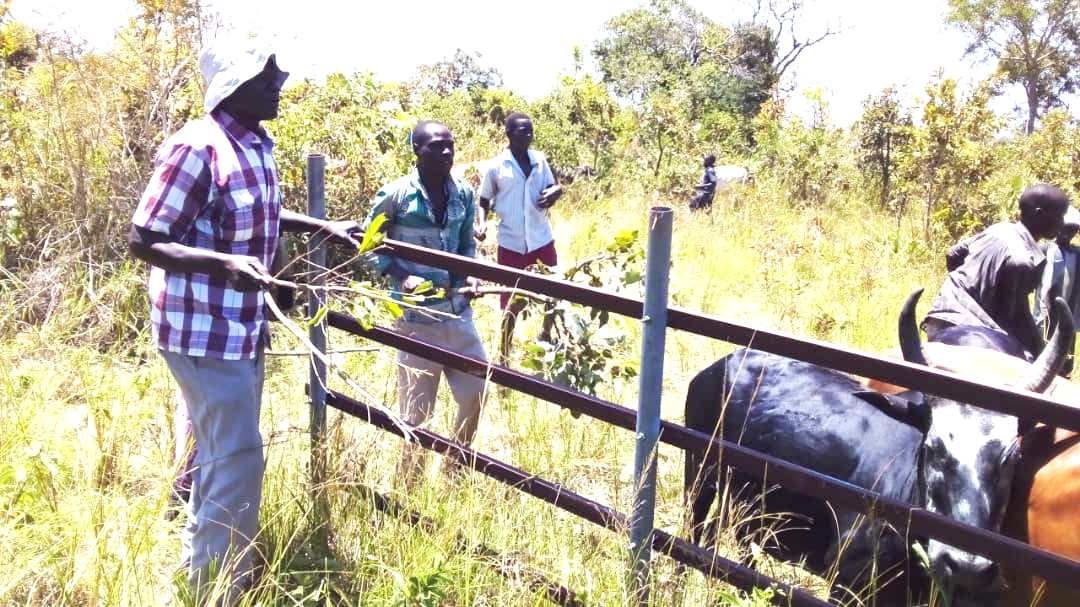KAPELEBYONG – Authorities from the Eastern district of Kapelebyong have demanded for more Foot and Mouth Disease (FMD) vaccines from the Ministry of Agriculture Animal Industry and Fisheries (MAAIF) to achieve a 100% vaccination target.
This was made on Wednesday as the production department concluded the two weeks vaccination exercise against Foot and Mouth Disease.
The outbreak was confirmed in November 2019, resulting into numerous cattle deaths in the sub counties of Acowa, Akoromit, Alito and Obalanga.
After close to two years of waiting for vaccines, the government through the Ministry of Agriculture Animal Industry and Fisheries (MAAIF) dispatched them this month to vaccinate the cattle in the affected sub counties.
Emmanuel Opio, the Kapelebyong district Communications Officer told theCooperator that the Ministry of Agriculture Animal Industry and Fisheries delivered 7,000 doses of Foot and Mouth Disease vaccines to the district which were shared amongst the affected sub-counties.
He said that they have vaccinated only 7,000 cattle from the four sub-counties which are the hot spots, according to the ministry.
However, he noted that the vaccines were inadequate to meet the overwhelming numbers of cattle and they have requested for more vaccines to reach at least 70% target in the affected sub-counties.
Statistics from the office of the district production department indicates that the four sub-counties of Obalang, Alito, Acowa and Akoromit have more than 20,000 heads of cattle.
Meanwhile, Raymond Ekita, the acting District Veterinary Officer (DVO) revealed that his office has written to the Ministry of Agriculture Animal Industry and Fisheries asking for more vaccines.
He appealed for calm among the livestock farmers as the district waits for feedback from the ministry in regards to the request for more doses of the vaccine.
Charles Obongo, a resident of Ajeleiki village in Acowa sub-county said the concluded vaccination exercise is a relief to the farmers in the district.
“Since the Foot and Mouth Disease outbreak was detected by MAAIF officials in November, 2019, we have been losing livestock which are our only source of livelihood,” said Obongo.
Simon Opolot, another livestock farmer from Alito sub-county said the vaccination exercise had been long overdue and they were running out of patience.
WHAT IS FOOT AND MOUTH DISEASE (FMD)?
Dr. Robert Ojala, the Veterinary Inspector in the Ministry of Agriculture Animal Industry and Fisheries in charge of Teso-Karamoja regions describes Foot and Mouth Disease (FMD) as a severe, highly contagious viral disease of cattle and swine.
It also affects sheep, goats, deer, and other cloven-hoofed ruminants. FMD is not recognized as a zoonotic disease.
According to him, the disease spreads very quickly if not controlled and because of this is a reportable disease.
Causes
Dr. Ojala said that foot and mouth disease is caused by a virus of which there are seven ‘types,’ each producing the same symptoms and distinguishable only in the laboratory.
“The interval between exposure to infection and the appearance of symptoms varies between twenty-four hours and ten days, or even longer. The average time, under natural conditions, is three to six days,” he said.
Dr. Ojala explained that the virus survives in lymph nodes and bone marrow at neutral pH, but is destroyed in the muscle when pH is less than 6.0.
https://thecooperator.news/nwoya-under-attack-by-the-foot-and-mouth-disease/
He added that Foot and Mouth Disease outbreaks have been linked with the importation of infected meat and meat products and that the disease can also be spread by people, vehicles and other objects that have been contaminated by the virus.
On the side of the symptoms, Dr. Ojala outlined fever, blisters in the mouth and on feet, drop in milk production, weight loss, loss of appetite, quivering lips and frothing of mouth. Cows may develop blisters on teats and lameness as some of the symptoms the affected cattle presents.
Prevention
According to the Cattle Site, Foot and Mouth Disease is one of the most difficult animal infections to control. Because the disease occurs in many parts of the world, there is always a chance of its accidental introduction into an unaffected country.
Export restrictions are often imposed on countries with known outbreaks.
FMD outbreaks are usually controlled by quarantines and movement restrictions, euthanasia of affected and in-contact animals, and cleansing and disinfection of affected premises, equipment and vehicles.
Infected carcasses must be disposed off safely by incineration, rendering, burial or other techniques. Milk from infected cows can be inactivated by heating to 100°C [212°F] for more than 20 minutes. Slurry can be heated to 67°C [153°F] for three minutes.
Rodents and other vectors may be killed to prevent them from mechanically disseminating the virus.
Good biosecurity measures should be practiced on uninfected farms to prevent entry of the virus.
Vaccination
Vaccination can be used to reduce the spread of FMD or protect specific animals.
Foot and Mouth Disease vaccines must closely match the serotype and strain of the infecting strain.
Vaccination with one serotype does not protect the animal against other serotypes, and may not protect the animal completely or at all from other strains of the same serotype. Currently, there is no universal FMD vaccine.
Buy your copy of theCooperator magazine from one of our countrywide vending points or an e-copy on emag.thecooperator.news
